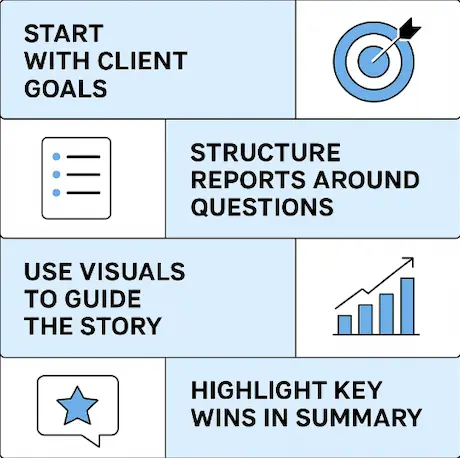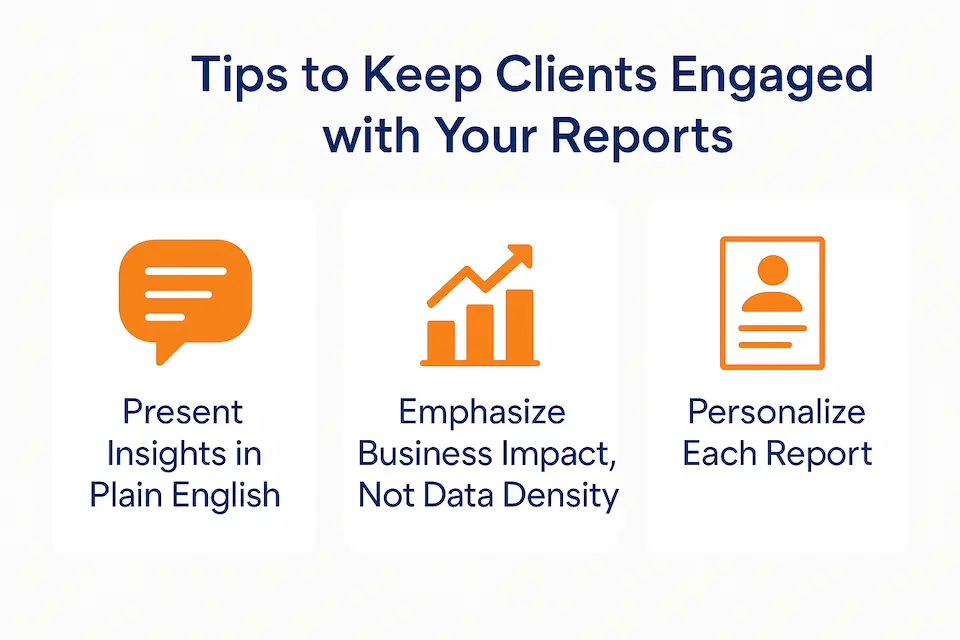November 11, 2025
In digital marketing, your results are only as strong as your ability to explain them. Clients don’t want a wall of numbers—they want to know what’s working, what’s not, and what comes next. The best agencies turn reporting into storytelling, helping clients see the bigger picture behind the metrics.
Here’s how to create marketing reports that don’t just inform, but impress.
Why Reporting Is More Than Just Numbers
The Problem with Traditional Marketing Reports
Most agencies send reports packed with charts, acronyms, and platform screenshots. While technically “complete,” they’re often disconnected from what the client actually cares about: business impact. A client doesn’t think in terms of CTR or bounce rate—they think in leads, revenue, and ROI.
A report without context leaves them wondering if their investment is paying off. That disconnect can quietly erode trust.
Why Storytelling Builds Client Trust and Retention
When you translate data into a story, you give the numbers meaning. A well-told story connects cause and effect—showing why performance changed and what actions are driving progress. Clients stop seeing your report as a technical document and start seeing it as a narrative of growth.
How to Turn Data into a Narrative

Numbers by themselves don’t tell a story, context does. The key to impactful reporting is connecting performance data to the why behind it. When you turn metrics into meaningful insights that align with business goals, clients can clearly see the value of your work and how each strategy contributes to growth.
Start with the Client’s Goals, Not the Metrics
Every story needs a central theme. For reporting, that theme should always tie back to the client’s goals. Instead of starting with “organic traffic increased by 12%,” start with “We increased qualified traffic to your top service page, driving more leads.”
If your client is focused on visibility, highlight SEO performance reports that show keyword and traffic improvements. If paid conversions are the priority, link your story to PPC campaign insights and how ad optimizations contributed to overall growth.
Structure Reports Around Questions You’re Answering
Try organizing sections around the questions clients actually ask:
-
What happened this month?
-
Why did it happen?
-
What are we doing next?
This creates a logical, conversational flow and keeps the focus on insight—not overload.
Use Visuals to Guide the Story
Charts, comparisons, and color-coded highlights help data make sense at a glance. For example:
-
A month-over-month bar graph showing traffic growth
-
A line chart comparing conversions to spend
-
Highlight boxes that summarize “Key Wins”
Visuals reinforce the narrative, turning complex data into a clear, digestible story.
Building the Perfect Monthly Report
Section 1 – Executive Summary with Key Wins
Open with a 3–4 sentence summary that highlights performance outcomes and next steps. Example:
“Organic leads increased 15% this month, largely driven by new blog content targeting [keyword group]. Paid conversions rose 8% after adjusting ad copy in Google Ads.”
This section should read like a briefing you’d send to an executive.
Section 2 – Channel-Level Insights
Break results down by major channels—SEO, PPC, and social—and include a short analysis for each. Avoid data dumps. Instead, interpret:
-
SEO: “Ranking gains for high-intent terms are driving more qualified traffic.”
-
PPC: “Lower CPCs this month improved ROAS by 12%.”
-
Social: “Engagement is up after shifting toward video posts.”
If you want to see what that looks like in practice, check out some of our real-world results we’ve driven.
Section 3 – Next Steps and Strategy Adjustments
Always close with action items. This shows proactivity and keeps momentum going. Example:
“Next month, we’ll expand on-page optimizations to your service pages and test new ad creative to boost CTR.”
Tips to Keep Clients Engaged with Your Reports

Even the most insightful report can fall flat if it’s hard to read or overloaded with data. The key is keeping clients engaged, helping them see the story behind the numbers without feeling overwhelmed. By focusing on clarity, business relevance, and personalization, you’ll turn each report into something clients actually look forward to reviewing.
Present Insights in Plain English
Replace jargon with relatable language. Instead of “CTR increased 20%,” say “More people are clicking your ads than last month.” Clarity always beats complexity.
Emphasize Business Impact, Not Data Density
One clear insight beats 10 raw data points. Focus your energy on explaining why a metric matters and how it affects their goals.
Personalize Each Report
No two clients have the same priorities. For one, lead volume may be key. For another, cost per acquisition might matter more. Customizing each report builds trust and shows genuine partnership.
Final Thoughts
A great marketing report does more than share data—it tells a story of progress, strategy, and impact. When clients understand their growth in context, they stay confident in your partnership and excited for what’s next.
Want to see what a data-driven, story-focused report looks like? Talk to our team and we’ll show you how we turn performance data into insights that actually move the needle.
Get your rankings back today.
Ready to make your reports actually matter? Let’s turn your data into stories that sell results.